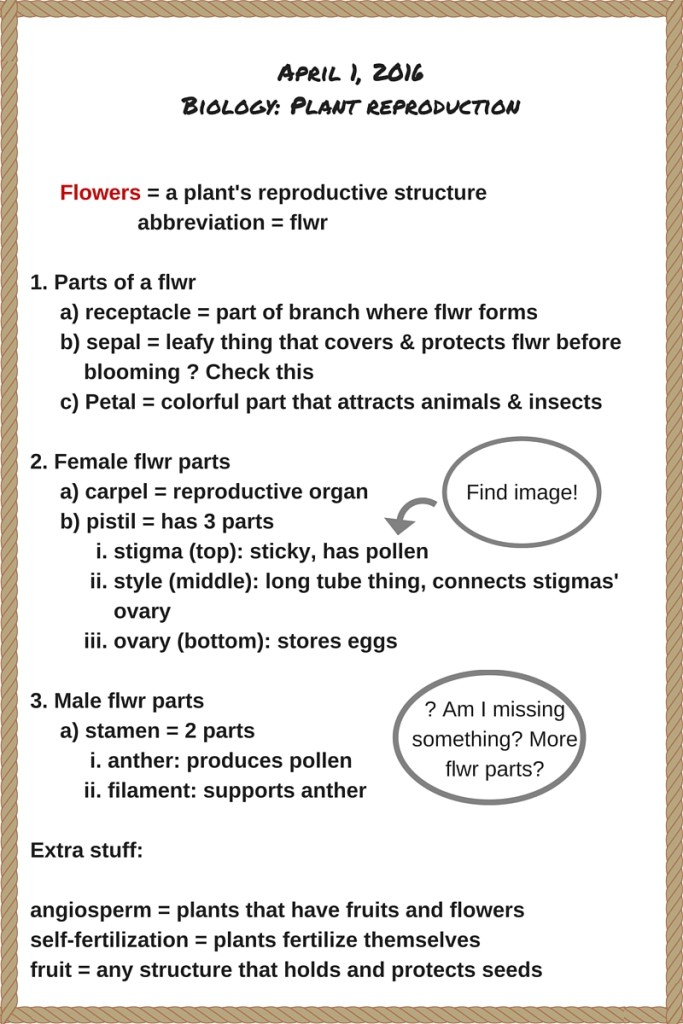By Katie Azevedo, M.Ed.
If you are a student of any age, you need to know how to take notes in a lecture class. This is an essential skill.
The strategies below should help you refine your note-taking habits so you’ll nail that open-notebook test, pay attention in class, understand what you’re learning, and actually get something out of your lecture classes.
How to take notes in a lecture class
Taking notes in a lecture class is different from taking notes from a textbook. If you’re looking for that information, then you want these 11 strategies for taking notes from a textbook.
1. Figure out your note-taking style.
Do you like paper and pen? Tablet or iPad? It doesn’t really matter the tool you use to take the notes, as long as it works for you.
Some students like the idea of using tech, but then get so overwhelmed with how to use it that they end up with sloppy or incomplete notes.
Some students prefer taking notes on paper during class, but then get overwhelmed with how to organize all their papers.
Figuring out what works may take time, but try both ways before you settle on one. You might even end up using both methods, depending on the class and other factors.
If you prefer to take notes on your tablet or iPad, there are excellent note-taking apps out there, many of them free. (Check out Notability, Paper and Note Taker.) Some only allow you to input text, but most let you draw diagrams and other free-form objects.
2. Capture the information.
Once you’ve chosen your tool, you need to capture what your teacher is teaching you, as he or she is teaching it.
This can be tricky, as some teachers talk so fast, without pausing to ask class questions, that you have a hard time listening and writing notes simultaneously.
Looking for tips about taking notes from a video? Here are 19.
Here are some strategies for taking notes as you listen to a lecture:
a) Date and title your notes. Obvious but it’s important. Don’t title notes from Monday’s biology class “Biology,” because that tells you nothing about what the lesson is. Instead, be as specific as possible. Try something like “Reproductive organs in flowers” or “How genes mutate” or whatever your teacher tells you the class is going to be about. If he or she doesn’t state in the beginning of class what the lesson is, then ask.
b) Create your own symbols and abbreviations for words or concepts that your teacher keeps repeating. For example, if you need to write the word “heterogeneous” more than a few times, use an abbreviation such as “HeteroG” or “HetG” instead of spelling out the whole word. Doing this saves so much time!
c) Use a split-page system as I explain here, or use a bullet or numbered-bullet format. Bullet points save time, and are a great way to organize key points. Here’s how to work a bullet system:
- Start with the largest idea. Let’s say the whole lesson is about reproductive organs in flowers. That would be your main title. Under that, your first subtitle might be “Reproductive organs of female flowers.” Under that, using bullets, write down all the smaller details about female flower parts – perhaps what they are, how many there are, etc.
- Once your teacher begins talking about the reproductive organs of male flowers, you create a new subtitle, because you’ve now moved onto a slightly different subject. Keep going in this manner, creating new titles and subtitles as the topic narrows or changes.
- Tip: When in doubt, and you can’t figure out whether to continue with one subtitle or create a new subtitle, create a new subtitle.
- During the capturing phase, you might occasionally miss what your teacher says, either because you didn’t hear it or didn’t understand it. If you didn’t understand something, or didn’t hear it, raise your hand and ask him or her to explain or repeat the point. If that’s not possible, put a question mark (?) in your notes to indicate that information is missing. You’ll come back to this in step 3.
- Pay attention to your teacher’s cues. If your teacher says something like, “OK, this is really important,” or “Now, what this all means is … “ or other similar expressions, star this part of your notes. (As in, literally draw a star in your notebook next to what you’re writing down.)
- Leave enough space between bulleted lists, in case you need to add more items later.

d) Record the lecture. If you really struggle with note-taking during class, you could always record the lecture using a voice memo app or something similar. (Most teachers should be fine with you doing this – of not, then explain your situation to them, or, um, hide your phone!)
You can start and stop the recording whenever you need to – don’t record every minute of the class. Getting an audio recording of the lesson frees up your mind to actually listen to what the teacher is saying, instead of scrambling to keep up with note-taking.
However, if you’re easily distracted, you could get even more distracted with this method, as you might falsely think you can zone out and just listen to the recording later. To prevent this, try taking notes and recording your teacher, using the recording as a backup in case you miss something.
3. Review your notes and fill in the gaps.
This is such an important step.
Here’s what you do: Remember in step 2 you are taking notes quickly, using mostly fragments and bullets. This third step is where you complete the sentences.
Later, but definitely on the same day you take the notes, go back into your notebook and fill in any missing information: fill out abbreviated words, complete sentences, clean up bullets, make titles and subtitles more accurate, and figure out what information should replace any question marks. To do this, consult your textbook or Google. If you have a question mark in your notes next to “Flowers that cross breed with other flowers are called … ?” you could totally Google that and get the answer “hybrid.”
Referring to the image above, you would type out flwr to flower. Research to see if there are any more male flower parts you missed during class. Google an image of the flower parts to better visualize the material. Put all definitions in one color. Etc.
If you hand-wrote your notes, try typing them up at this point, or at least rewriting them to make them cleaner and more organized. (Paper gets messy when editing, erasing and rewriting.) If you typed your class notes, then you don’t have to retype them, but definitely clean them up, edit, and re-read what you wrote.
There are multiple benefits to taking this extra step. First, you’ll have neater notes. Second, by rewriting your notes, you’re actually studying, processing, and learning them. Learning happens when we repeatedly revisit information. Typing up your notes gets you one step closer to committing the information to memory.
If you captured your notes via recorder, then now is when you transcribe everything to paper. Play the recording while writing or typing up important material from the recording. If you just used the recorder as a backup, but still took notes during class, then use the recording to “fill in the gaps” on any parts you missed.
4. Organize and store your notes.
If you use a spiral-bound notebook to take notes during class, typing them up in step 3 means you’ll be using loose-leaf paper. So logically, you need a place to store your new notes. I’d recommend a 3-ring notebook for each class (if you take a ton of notes) or one larger 3-ring notebook where you could store your notes for all your classes, separated by tab dividers. Using a 3-ring binder allows you to reorder your notes, remove notes to make photocopies, and add in relevant class handouts and worksheets. These are my top strategies for organizing notes.
5. Study!
When you know how to take notes in a lecture class, the studying process is so much easier. You’ll know exactly what to study, you’ll know where all the information is, and you’ll actually be able to read it.
Of course, you still have to put in the hours of studying the information (learn how to study anything, here), but you won’t have to waste time finding what you’re looking for.
I hope my strategies for how to take notes in a lecture class help you feel more organized and more in control of your note-taking system. It’s never too late or too early to improve your school habits, so whether you’re in seventh grade or college, you can benefit from following my five steps to better notes.

